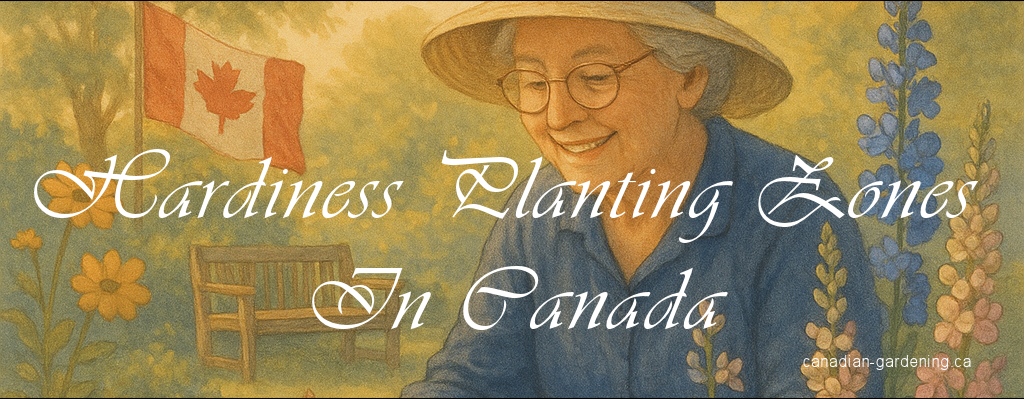British Columbia
- Abbotsford – Zone 8a
- Chilliwack – Zone 8b
- Cranbrook – Zone 4b - 5a
- Kamloops – Zone 5b
- Kelowna – Zone 6a -7a
- Maple Ridge – Zone 8a
- Nanaimo – Zone 8b
- Nelson – Zone 6a
- Prince George – Zone 4a - 4b
- Salmon Arm - Zone - 6a - 6b
- Surrey – Zone 8b
- Telkwa – Zone 3b
- Vancouver – Zone 8b
- Victoria – Zone 9a
Alberta
- Banff – Zone 3a
- Brooks – Zone 4a
- Calgary – Zone 4a
- Camrose – Zone 3b
- Claresholm – Zone 3b -4a
- Edmonton – Zone 3b
- Fort McMurray – Zone 2b
- Grande Prairie – Zone 3a
- Lethbridge – Zone 4b
- Medicine Hat – Zone 4a
- Red Deer – Zone 3b
- Spruce Grove - Zone - 3b - 4a
Manitoba
- Brandon – Zone 3a
- Dauphin – Zone 3a
- Flin Flon – Zone 2b
- Portage la Prairie – Zone 3a
- Selkirk – Zone 3b
- Steinbach – Zone 3a
- The Pas – Zone 2b
- Thompson – Zone 2a
- Winkler – Zone 3a
- Winnipeg – Zone 3b
Ontario
- Barrie – Zone 5a
- Belleville – Zone 6a
- Bobcaygeon - Zone 4b - 5a
- Bowmanville - Zone 6a - 6b
- Burlington - Zone 6b - 7a
- Brighton - Zone 6a
- Cobourg - Zone 6a
- Colborne – Zone 6a
- Colchester - Zone 6a - 6b
- Cornwall - Zone 5b - 6a
- Grimsby - Zone 7a
- Hamilton – Zone 6b - 7a
- Kingston – Zone 5b
- London – Zone 6a
- Niagara Falls - Zone 6a - 6b
- North Bay – Zone 4a
- Ottawa – Zone 5a
- St.Catharines - Zone 6a - 6b
- Sudbury – Zone 4b
- Thunder Bay – Zone 3b
- Toronto – Zone 6a
- Windsor – Zone 7a
Quebec
- Brigham - Zone 5b - 6a
- Chicoutimi – Zone 3b
- Gatineau – Zone 5a
- Montreal – Zone 6a
- Quebec City – Zone 5a
- Rimouski – Zone 4a
- Rouyn-Noranda – Zone 3a
- Lasalle - Zone 6a - 6b
- Sept-Îles – Zone 3a
- Sherbrooke – Zone 4b
- Trois-Rivières – Zone 4b
- Val-d'Or – Zone 3b
New Brunswick
- Bathurst – Zone 5a
- Edmundston – Zone 4b
- Fredericton – Zone 5a
- Moncton – Zone 6a
- Saint John – Zone 6a
Nova Scotia
- Antigonish – Zone 5b
- Halifax – Zone 6a
- New Glasgow – Zone 5b
- Truro – Zone 5b
- Yarmouth – Zone 6b
Prince Edward Island
- Charlottetown – Zone 5b
- Montague – Zone 5a
- Summerside – Zone 5b
Newfoundland and Labrador
- Corner Brook (Newfoundland) – Zone 5a
- Gander (Newfoundland) – Zone 5a
- Happy Valley-Goose Bay (Labrador) – Zone 2b
- St. John’s (Newfoundland) – Zone 6a
- Wabush (Labrador) – Zone 2a
Yukon
- Dawson City – Zone 2b
- Watson Lake – Zone 2a
- Whitehorse – Zone 3b
Northwest Territories
- Fort Smith – Zone 3a
- Inuvik – Zone 1a
- Yellowknife – Zone 2b
Nunavut
- Arviat – Zone 0
- Iqaluit – Zone 0
- Rankin Inlet – Zone 0
Tip: Zones are estimates. Local microclimates, wind exposure and elevation can
affect your actual planting conditions. When in doubt, ask a nearby nursery!
"Canada's official plant hardiness zones are based on data from 1981 to 2010. But local conditions are
changing — many areas may be a little warmer now, especially near cities or lakes."
Understanding Plant Hardiness Zones: Canada vs. U.S.
Plant hardiness zones help gardeners choose plants that can survive the winter in their area. Both Canada and the U.S. use numbered zones (like Zone 3, Zone 6, etc.), but they aren't always exactly the same. The U.S. system is based only on the lowest winter temperatures. In Canada, our zones also consider other factors like wind, snow cover and how long the growing season is. That means a Zone 6 in Canada may still be colder and shorter than a Zone 6 in the U.S. If you're looking at a U.S. seed packet or planting guide, it's safest to choose plants rated for a slightly colder zone than your own—just to be sure they'll survive our Canadian conditions!
Hardiness Zones: Same Numbers, Different Winters
Think of plant zones like snow boots: size 6 in the U.S. might keep your toes cozy in a light frost, but here in Canada, size 6 better come with wool socks and a shovel. Both countries use numbered zones to tell us how cold it gets, but the Canadian system takes more into account—like wind, snow cover, and how long our garden season actually lasts. That means a U.S. Zone 6 might feel like a mild fall, while Canadian Zone 6 is still brushing snow off the daffodils.
